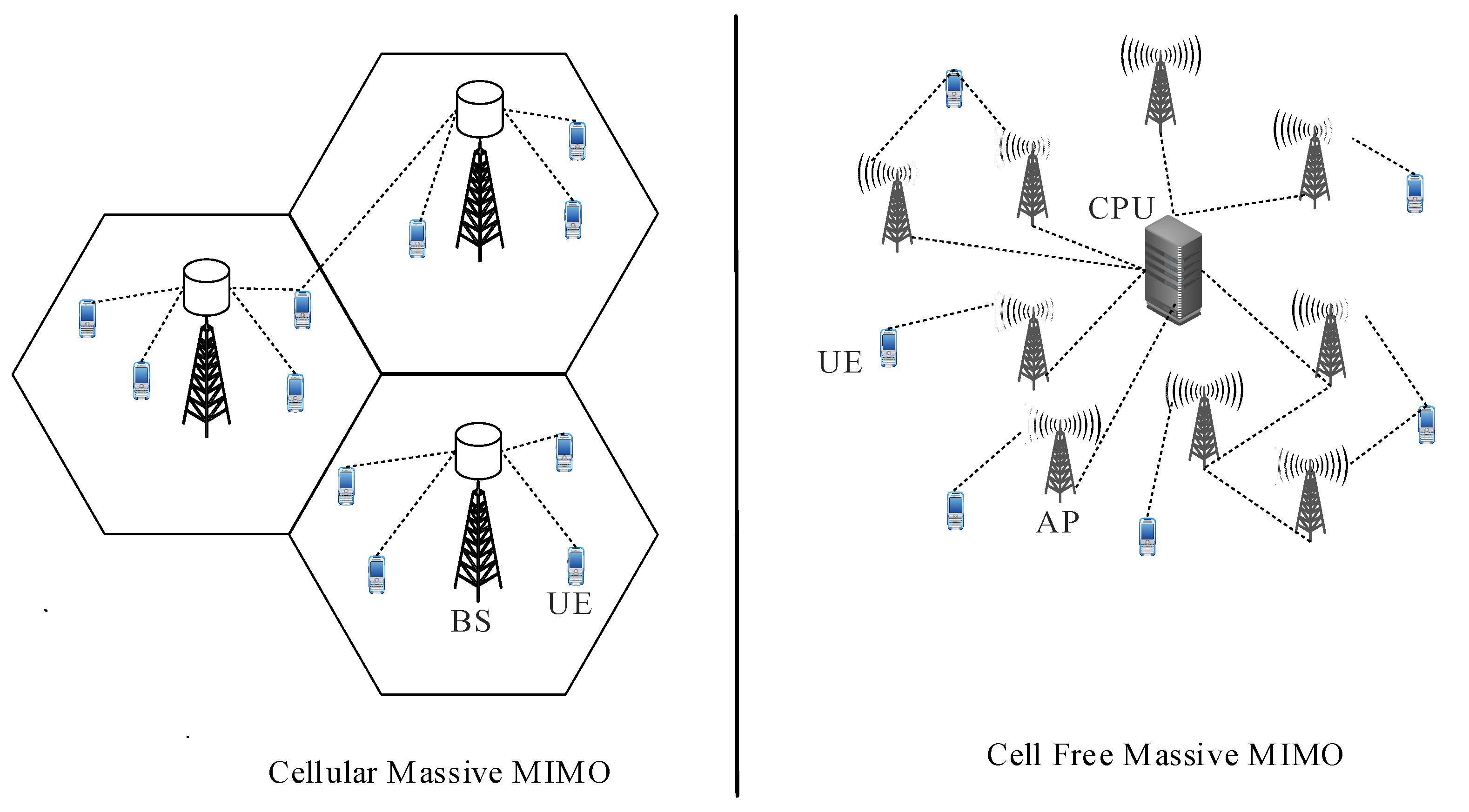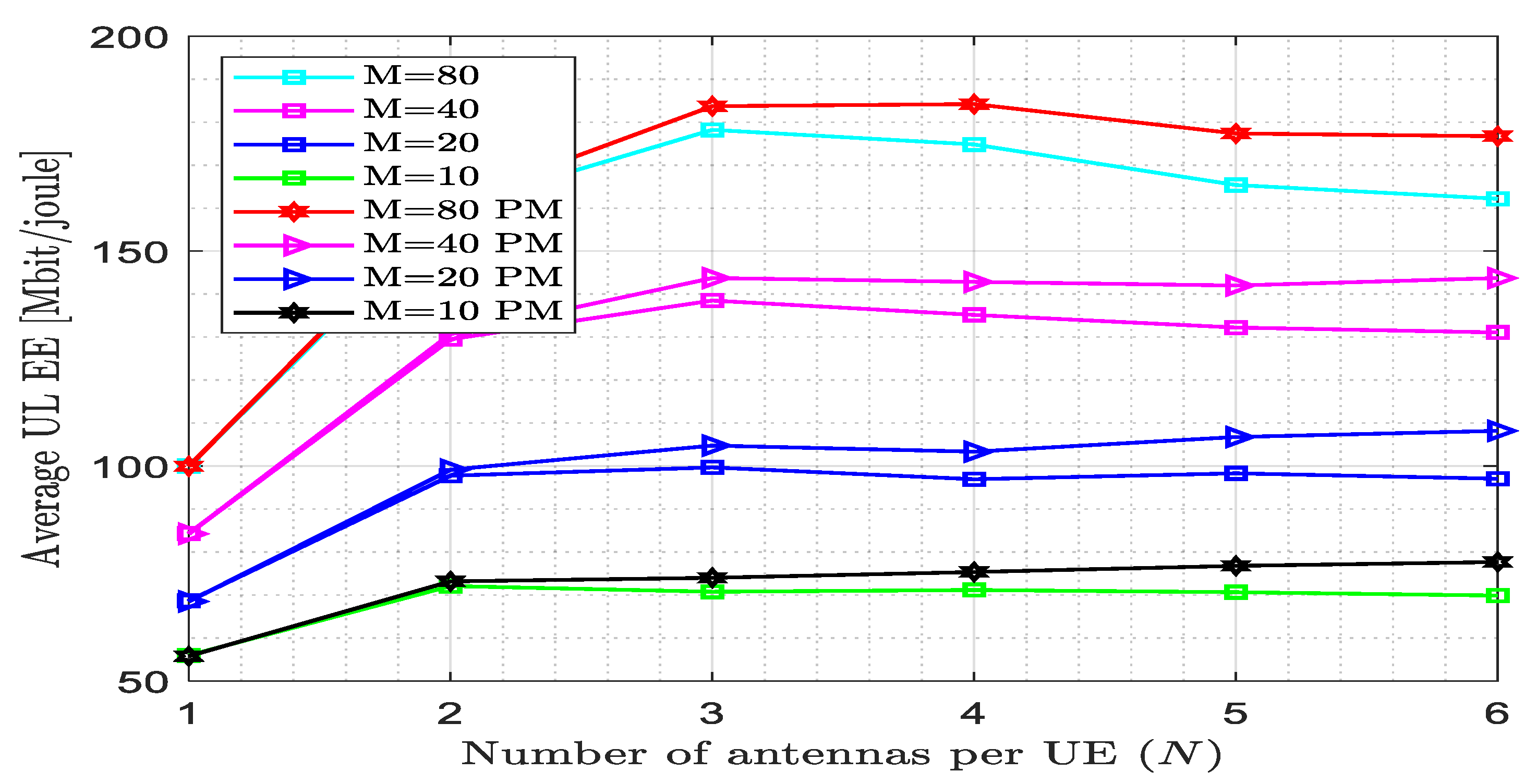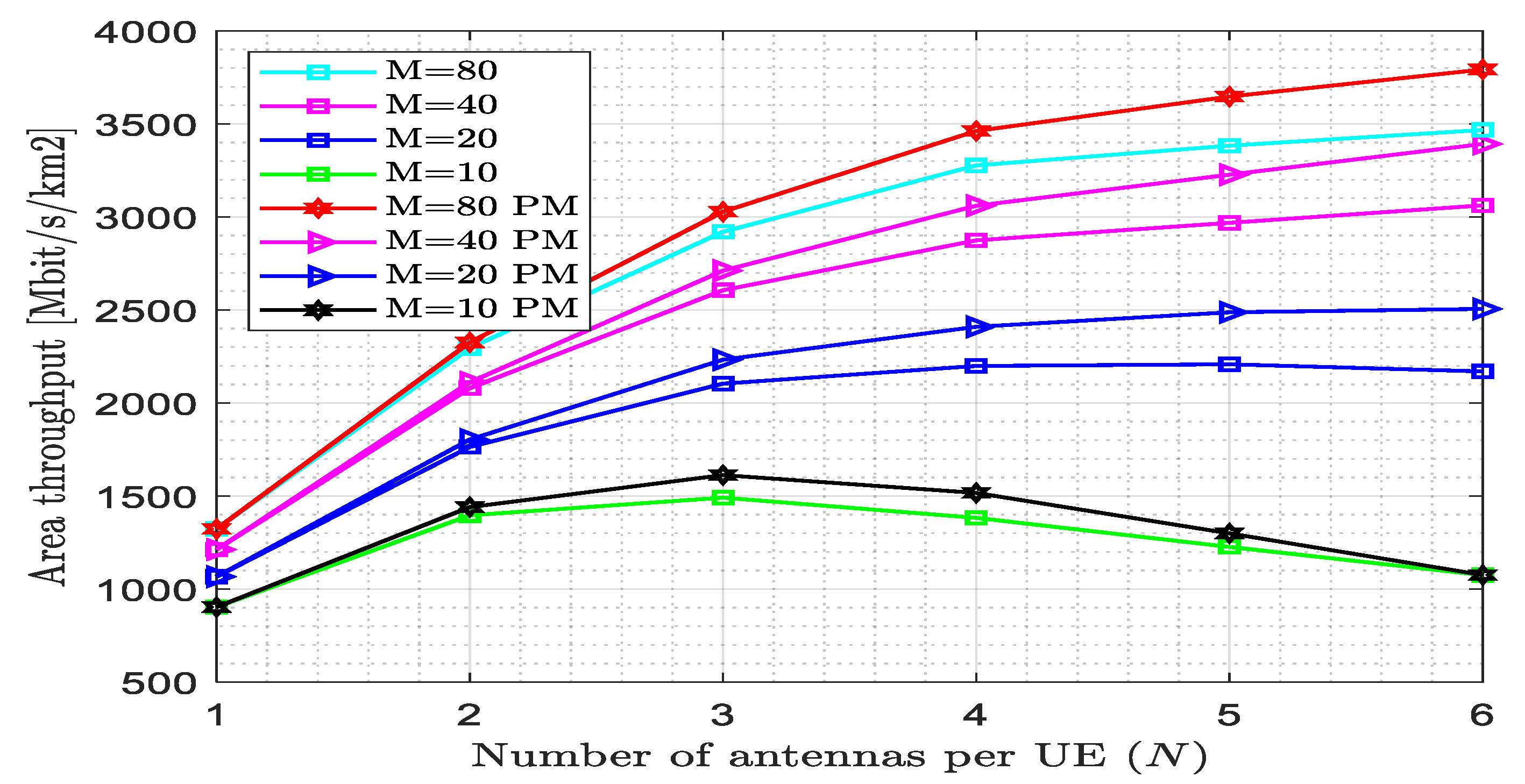Performance Evaluation of Uplink Cell-Free Massive MIMO Network Under Weichselberger Rician Fading Channel
Abstract
1. Introduction
2. Related Work
2.1. System Model
2.2. Uplink Data Transmission
2.3. MMSE Combining
2.4. Spectral Efficiency of the System
3. Proposed Method
3.1. Precoding Matrix Design
3.2. Performance Metrix of the System
- Area throughput
- Computational Complexity
- Energy Efficiency
4. Results and Discussion
4.1. Impact of the Number of Users and the Pilot Reuse Factor per Access Point on Spectral Efficiency
4.2. Impact of the Number of Users and the Pilot Reuse Factor on Energy Efficiency
4.3. Impact of the Number of Users and the Pilot Reuse Factor on Area Throughput
5. Conclusions
Author Contributions
Funding
Data Availability Statement
Conflicts of Interest
Abbreviations
| AP | Access Point |
| EE | Energy Efficiency |
| MMSE | Minimum Mean Square Error |
| MIMO | Multiple Input Multiple Output |
| SE | Spectral Efficiency |
| DL | Downlink |
| UL | Uplink |
| UE | User Equipment |
References
- Truong, K.T.; Heath, R.W. The Viability of Distributed Antennas for Massive MIMO Systems. In Proceedings of the 2013 Asilomar Conference on Signals, Systems and Computers, Pacific Grove, CA, USA, 3–6 November 2013; pp. 1318–1323. [Google Scholar] [CrossRef]
- Björnson, E.; Zakhour, R.; Gesbert, D.; Ottersten, B. Cooperative Multicell Precoding: Rate Region Characterization and Distributed Strategies with Instantaneous and Statistical CSI. IEEE Trans. Signal Process. 2010, 58, 4298–4310. [Google Scholar] [CrossRef]
- Ngo, H.Q.; Ashikhmin, A.; Yang, H.; Larsson, E.G.; Marzetta, T.L. Cell-Free Massive MIMO versus Small Cells. IEEE Trans. Wirel. Commun. 2017, 16, 1834–1850. [Google Scholar] [CrossRef]
- Foschini, G.J.; Karakayali, K.; Valenzuela, R.A. Coordinating Multiple Antenna Cellular Networks to Achieve Enormous Spectral Efficiency. IEE Proc. Commun. 2006, 153, 548–555. [Google Scholar] [CrossRef]
- Zhang, J.; Chen, S.; Lin, Y.; Zheng, J.; Ai, B.; Hanzo, L. Cell-Free Massive MIMO: A New Next-Generation Paradigm. IEEE Access 2019, 7, 99878–99888. [Google Scholar] [CrossRef]
- Lu, L.; Li, G.Y.; Swindlehurst, A.L.; Ashikhmin, A.; Zhang, R. An Overview of Massive MIMO: Benefits and Challenges. IEEE J. Sel. Top. Signal Process. 2014, 8, 742–758. [Google Scholar] [CrossRef]
- Buzzi, S.; D’Andrea, C.; Zappone, A.; D’Elia, C. User-Centric 5G Cellular Networks: Resource Allocation and Comparison with the Cell-Free Massive MIMO Approach. IEEE Trans. Wirel. Commun. 2020, 19, 1250–1264. [Google Scholar] [CrossRef]
- Yang, H.; Marzetta, T.L. Energy Efficiency of Massive MIMO: Cell-Free vs. Cellular. In Proceedings of the 2018 IEEE 87th Vehicular Technology Conference (VTC Spring), Porto, Portugal, 3–6 June 2018; pp. 1–5. [Google Scholar] [CrossRef]
- Björnson, E.; Sanguinetti, L. Cell-Free versus Cellular Massive MIMO: What Processing is Needed for Cell-Free to Win? In Proceedings of the 2019 IEEE 20th International Workshop on Signal Processing Advances in Wireless Communications (SPAWC), Cannes, France, 2–5 July 2019; pp. 1–5. [Google Scholar] [CrossRef]
- Chen, S.; Zhang, J.; Zhang, J.; Björnson, E.; Ai, B. A Survey on User-Centric Cell-Free Massive MIMO Systems. Digit. Commun. Netw. 2022, 8, 695–719. [Google Scholar] [CrossRef]
- Nayebi, E.; Ashikhmin, A.; Marzetta, T.L.; Yang, H. Cell-Free Massive MIMO Systems. In Proceedings of the 2015 49th Asilomar Conference on Signals, Systems and Computers, Pacific Grove, CA, USA, 8–11 November 2015; pp. 695–699. [Google Scholar] [CrossRef]
- Interdonato, G.; Björnson, E.; Ngo, H.Q.; Frenger, P.; Larsson, E.G. Ubiquitous Cell-Free Massive MIMO Communications. EURASIP J. Wirel. Commun. Netw. 2019, 2019, 197. [Google Scholar] [CrossRef]
- Amadid, J.; Boulouird, M.; Belhabib, A.; Zeroual, A. On Channel Estimation for Rician Fading with the Phase-Shift in Cell-Free Massive MIMO System. Wirel. Pers. Commun. 2022, 124, 1923–1943. [Google Scholar] [CrossRef]
- Demir, Ö.T.; Björnson, E.; Sanguinetti, L. Foundations of User-Centric Cell-Free Massive MIMO. Found. Trends Signal Process. 2021, 14, 162–472. [Google Scholar] [CrossRef]
- Wang, Z.; Zhang, J.; Ai, B.; Yuen, C.; Debbah, M. Uplink Performance of Cell-Free Massive MIMO with Multi-Antenna Users over Jointly-Correlated Rayleigh Fading Channels. IEEE Trans. Wirel. Commun. 2022, 21, 7391–7406. [Google Scholar] [CrossRef]
- Demir, O.T.; Björnson, E.; Sanguinetti, L. Cell-Free Massive MIMO with Large-Scale Fading Decoding and Dynamic Cooperation Clustering. In Proceedings of the 25th International ITG Workshop on Smart Antennas (WSA), French Riviera, France, 10–12 November 2021; pp. 1–6. [Google Scholar]
- Özdogan, Ö.; Björnson, E.; Zhang, J. Performance of Cell-Free Massive MIMO with Rician Fading and Phase Shifts. IEEE Trans. Wirel. Commun. 2019, 18, 5299–5315. [Google Scholar] [CrossRef]
- Chen, S.; Zhang, J.; Björnson, E.; Zhang, J.; Ai, B. Structured Massive Access for Scalable Cell-Free Massive MIMO Systems. IEEE J. Mag. 2021, 39, 1086–1100. Available online: https://ieeexplore.ieee.org/abstract/document/9174860 (accessed on 23 August 2023). [CrossRef]
- Amadid, J.; Belhabib, A.; Zeroual, A. On Channel Estimation in Cell-Free Massive MIMO for Spatially Correlated Channels with Correlated Shadowing under Rician Fading. Int. J. Commun. Syst. 2022, 35, e5011. [Google Scholar] [CrossRef]
- Ammar, H.A.; Adve, R.; Shahbazpanahi, S.; Boudreau, G.; Srinivas, K.V. User-Centric Cell-Free Massive MIMO Networks: A Survey of Opportunities, Challenges and Solutions. IEEE Commun. Surv. Tutor. 2022, 24, 611–652. [Google Scholar] [CrossRef]
- Björnson, E.; Sanguinetti, L. Scalable Cell-Free Massive MIMO Systems. IEEE Trans. Commun. 2020, 68, 4247–4261. [Google Scholar] [CrossRef]
- Wang, Z.; Zhang, J.; Ngo, H.Q.; Ai, B.; Debbah, M. Uplink Precoding Design for Cell-Free Massive MIMO with Iteratively Weighted MMSE. IEEE Trans. Commun. 2023, 71, 1646–1664. [Google Scholar] [CrossRef]
- Li, X.; Zhang, J.; Wang, Z.; Ai, B.; Ng, D.W.K. Cell-Free Massive MIMO with Multi-Antenna Users over Weichselberger Rician Channels. IEEE Trans. Veh. Technol. 2022, 71, 12368–12373. [Google Scholar] [CrossRef]
- Björnson, E.; Hoydis, J.; Sanguinetti, L. Massive MIMO Networks: Spectral, Energy, and Hardware Efficiency. Found. Trends Signal Process. 2017, 11, 154–655. [Google Scholar] [CrossRef]
- Wang, Z.; Zhang, J.; Björnson, E.; Ai, B. Uplink Performance of Cell-Free Massive MIMO over Spatially Correlated Rician Fading Channels. IEEE Commun. Lett. 2021, 25, 1348–1352. [Google Scholar] [CrossRef]
- Weichselberger, W.; Herdin, M.; Ozcelik, H.; Bonek, E. A Stochastic MIMO Channel Model with Joint Correlation of Both Link Ends. IEEE Trans. Wirel. Commun. 2006, 5, 90–100. [Google Scholar] [CrossRef]
- Björnson, E.; Sanguinetti, L. Making Cell-Free Massive MIMO Competitive with MMSE Processing and Centralized Implementation. IEEE Trans. Wirel. Commun. 2020, 19, 77–90. [Google Scholar] [CrossRef]
- Li, X.; Jin, S.; Gao, X.; McKay, M.R. Capacity Bounds and Low Complexity Transceiver Design for Double-Scattering MIMO Multiple Access Channels. IEEE Trans. Signal Process. 2010, 58, 2809–2822. [Google Scholar] [CrossRef]
















| No. | Simulation Parameter | Type and Value |
|---|---|---|
| 1 | Pilot reuse factor (w) | 1, 2 |
| 2 | Uplink transmitter power (p) | 200 mW |
| 3 | Number of access points (M) | 10, 20, 40, 80 |
| 4 | Number of antennae per UE (N) | 1, 2, 3, 4, 5, 6 |
| 5 | Number of antennae per APs (L) | 4 |
| 6 | Number of user equipment (K) | 8, 10, 15, 20 |
| 7 | Coherence block | 200 to 800 |
| 8 | Bandwidth (B) | 1 MHz |
| 9 | Coverage area | 1 km by 1 km |
Disclaimer/Publisher’s Note: The statements, opinions and data contained in all publications are solely those of the individual author(s) and contributor(s) and not of MDPI and/or the editor(s). MDPI and/or the editor(s) disclaim responsibility for any injury to people or property resulting from any ideas, methods, instructions or products referred to in the content. |
© 2025 by the authors. Licensee MDPI, Basel, Switzerland. This article is an open access article distributed under the terms and conditions of the Creative Commons Attribution (CC BY) license (https://creativecommons.org/licenses/by/4.0/).
Share and Cite
Dessie, B.; Shaikh, J.; Iliev, G.; Nenova, M.; Syed, U.; Kumar, K.K. Performance Evaluation of Uplink Cell-Free Massive MIMO Network Under Weichselberger Rician Fading Channel. Mathematics 2025, 13, 2283. https://doi.org/10.3390/math13142283
Dessie B, Shaikh J, Iliev G, Nenova M, Syed U, Kumar KK. Performance Evaluation of Uplink Cell-Free Massive MIMO Network Under Weichselberger Rician Fading Channel. Mathematics. 2025; 13(14):2283. https://doi.org/10.3390/math13142283
Chicago/Turabian StyleDessie, Birhanu, Javed Shaikh, Georgi Iliev, Maria Nenova, Umar Syed, and K. Kiran Kumar. 2025. "Performance Evaluation of Uplink Cell-Free Massive MIMO Network Under Weichselberger Rician Fading Channel" Mathematics 13, no. 14: 2283. https://doi.org/10.3390/math13142283
APA StyleDessie, B., Shaikh, J., Iliev, G., Nenova, M., Syed, U., & Kumar, K. K. (2025). Performance Evaluation of Uplink Cell-Free Massive MIMO Network Under Weichselberger Rician Fading Channel. Mathematics, 13(14), 2283. https://doi.org/10.3390/math13142283







